 Divers exploring the wreck of the Rooswijk, an 18th century Dutch ship off the coast of Kent, England, have discovered a sealed seaman’s chest whose contents are unknown but could be actual treasure. The largest of several chests recovered from the wreck, it is about one meter long and could contain objects like sabre blades (known to have been on board) that need a long container. Or, like other chests previously recovered from the wreck, it could contain silver ingots and coins, a conventional treasure as well as a historical one.
Divers exploring the wreck of the Rooswijk, an 18th century Dutch ship off the coast of Kent, England, have discovered a sealed seaman’s chest whose contents are unknown but could be actual treasure. The largest of several chests recovered from the wreck, it is about one meter long and could contain objects like sabre blades (known to have been on board) that need a long container. Or, like other chests previously recovered from the wreck, it could contain silver ingots and coins, a conventional treasure as well as a historical one.
Of course, any contents at all would be archaeologically precious, but archaeologists dare not open it for risk of damaging the chest and/or its contents.
It may never be possible, or even desirable, to open the mystery chest. Conventional x-rays often don’t reveal much of heavily concreted objects. Angela Middleton, a conservation expert at Historic England, hopes to persuade the customs authorities to bring along one of the scanners they use at the port to check for people and goods hidden in lorries, and see if it shows up anything.
“We might find out it is impossible to open the chest without destroying it. Or we might find out what is in it and decide it’s just not worth even trying to open it,” she said.
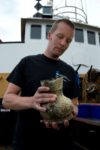 The Rooswijk, a three-masted Dutch East India (VOC) trading ship, had just set off from Amsterdam on its way to Jakarta with a hold full of silver bullion and coins to buy spices when it was blown off course in a storm and sank on the treacherous Goodwin Sands off Kent in January of 1740. Known as the Ship Swallower, the Goodwin devoured the Rooswijk and all 250 crew and passengers on board.
The Rooswijk, a three-masted Dutch East India (VOC) trading ship, had just set off from Amsterdam on its way to Jakarta with a hold full of silver bullion and coins to buy spices when it was blown off course in a storm and sank on the treacherous Goodwin Sands off Kent in January of 1740. Known as the Ship Swallower, the Goodwin devoured the Rooswijk and all 250 crew and passengers on board.
The ship was so heavily laden it went down in a flash. British newspapers reported on the wreck of a Dutch merchant ship in the storm. Letters and debris washed ashore. It’s not clear whether the VOC was made immediately aware of these reports. The voyage to Jakarta was so long Dutch East India officials wouldn’t have had reason to worry until after the ship failed to reach its scheduled stop at the Cape of Good Hope, months after its departure and sinking.
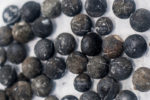 Whatever was left of the Rooswijk and its very heavy, very valuable cargo was covered over by the Goodwin Sands and its location remained a mystery for centuries. After years of documentary research and a magnetometer survey, a diver found the wreck and in 2005, a team of underwater archaeologists explored it. They recovered more than 1,000 artifacts, including musket parts, knives, sword blades, hilts and scabbards, pewter dinnerware, silver coins, more than 500 four-pound silver ingots. Because the wreck is owned by the Dutch government by virtue of its having absorbed the Dutch East India Company in 1798, the artifacts recovered from the wreck are property of the Netherlands and were returned to it. Some of them are now on display at the Maritime Museum in Vlissingen.
Whatever was left of the Rooswijk and its very heavy, very valuable cargo was covered over by the Goodwin Sands and its location remained a mystery for centuries. After years of documentary research and a magnetometer survey, a diver found the wreck and in 2005, a team of underwater archaeologists explored it. They recovered more than 1,000 artifacts, including musket parts, knives, sword blades, hilts and scabbards, pewter dinnerware, silver coins, more than 500 four-pound silver ingots. Because the wreck is owned by the Dutch government by virtue of its having absorbed the Dutch East India Company in 1798, the artifacts recovered from the wreck are property of the Netherlands and were returned to it. Some of them are now on display at the Maritime Museum in Vlissingen.
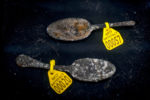 Because of its historical importance and rarity — just a third of the 250 known VOC wrecks have ever been found and the Rooswijk is the only one of them to be scientifically investigated — in 2007 the site was designated a protected wreck. The designation made any unauthorized interference with it a crime. Still, the location was kept under wraps to discourage treasure hunters from trying their luck.
Because of its historical importance and rarity — just a third of the 250 known VOC wrecks have ever been found and the Rooswijk is the only one of them to be scientifically investigated — in 2007 the site was designated a protected wreck. The designation made any unauthorized interference with it a crime. Still, the location was kept under wraps to discourage treasure hunters from trying their luck.
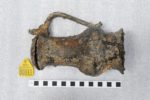 Last year, the Cultural Heritage Agency of the Netherlands and Historic England launched a new excavation of the Rooswijk. There was an urgent need to survey the site because changing tides had drastically shifted the deep silt layers, exposing timbers that have long been shielded under the sediments. This not only triggered precipitous decay, but it made it more likely that looters might find the ship.
Last year, the Cultural Heritage Agency of the Netherlands and Historic England launched a new excavation of the Rooswijk. There was an urgent need to survey the site because changing tides had drastically shifted the deep silt layers, exposing timbers that have long been shielded under the sediments. This not only triggered precipitous decay, but it made it more likely that looters might find the ship.
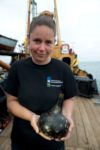 Working with the divers who first explored the wreck in 2005, archaeologists have recovered pewter tankards and spoons, glass brandy bottles, elaborately carved knife handles, shoes, wine glasses with twist stems, an onion jar, cooking tiles, Mexican silver dollars and cut up pieces of eight. All of the artifacts have been taken to a huge warehouse in Ramsgate to be recorded and receive any emergency treatment they require. They will then be moved to a Historic England facility for further conservation before being returned to the Netherlands.
Working with the divers who first explored the wreck in 2005, archaeologists have recovered pewter tankards and spoons, glass brandy bottles, elaborately carved knife handles, shoes, wine glasses with twist stems, an onion jar, cooking tiles, Mexican silver dollars and cut up pieces of eight. All of the artifacts have been taken to a huge warehouse in Ramsgate to be recorded and receive any emergency treatment they require. They will then be moved to a Historic England facility for further conservation before being returned to the Netherlands.
There will be an open day at the Ramsgate warehouse on September 16th to give the public what may be their only chance and seeing some of these finds before they leave the country.
The “Zeeuws Maritiem muZEEum” in Vlissingen (yes, in ZEEland) -which also is referred to by some as “Flushing”- seems to be the former home of Cornelis Lampsins (d. 1664), Baron of Tobago, VOC shareholder and Vlissingen Mayor.
I have seen Jakarta harbor (Batavia), the destination that the ship never reached, I even made it -shortly- to Kent and Vlissingen, but I had no idea that there was a “Maritiem muZEEum” 😱
Fifteen men on the dead man’s chest
…Yo-ho-ho, and a bottle of rum!